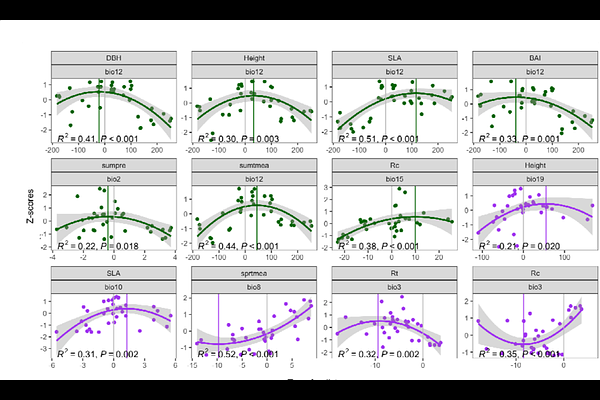Genetic and plastic effects on trait variability in two major tree species: insights from common garden experiments across Europe

Genetic and plastic effects on trait variability in two major tree species: insights from common garden experiments across Europe
Martinez-Sancho, E.; Christian, R.; Fonti, P.; Benito-Garzon, M.; Bigler, C.; Miranda, J. C.; Argelich, M.; Chmura, D. J.; Clark, J.; Kjaer, E. D.; Hansen, J. K.; Karopka, M.; Liziniewicz, M.; Notzli, M.; Palsson, A.; Richardson, L.; Sahan, E.; Verstege, A.; Whittet, R.; Vitasse, Y.
AbstractPhenotypic plasticity and genetic adaptation are key mechanisms that enable species to respond to changing environments. Tree traits do not vary independently but rather in coordination. However, our understanding of whether functional traits are governed by the same mechanism is far from complete. Thus, we aim at assessing the drivers of trait variability of sessile oak and European beech provenances across their distribution ranges. We estimated growth-related and leaf morphological traits from 9 and 11 provenances of oak and beech, respectively, grown in four different common gardens distributed across their respective distribution areas. Overall, phenotypic plasticity played a dominant role in explaining individual trait variability. For most oak traits, variation among provenances and genetically based plasticity were correlated with the climate of origin, whereas fewer significant associations were found for beech. In oak, climate-transfer distance analyses revealed that traits such as DBH, height, specific leaf area, and long-term growth responses to summer temperature decreased when provenances were moved away from their local precipitation regime. In beech, significant climate-transfer distances were fewer and primarily related to temperature-related parameters. These results suggest that natural selection and local adaptation may play a secondary but notable role. The pattern of multi-trait phenotypes indicates that resource-use strategies among provenances covary with the temperatures of origin in both species. The limited genetic responses in beech could hinder its survival if it reaches the boundaries of trait plasticity, while oak may better adjust through adaptation. Our study contributes to a better understanding of the interplay between genetic adaptation and phenotypic plasticity in long-lived forest trees.